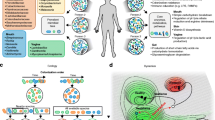Abstract
Male liver was grafted to kidney beds in syngeneic female mice. Relative influences ofH-2 haplotype, genetic background or interaction ofH-2 haplotype with genetic background on anti-H-Y response were evaluated using 27 inbred strains carrying eightH-2 haplotypes of independent origin and three naturally occurring recombinants. Females ofH-2 b haplotype acutely rejected the male graft as is reported for other tissue graft systems. AnH-2 haplotype influence was found for all haplotypes studied, with a greater variation of immunologic response revealed by histological analysis of liver grafts than is demonstrated by skin grafts. Strains carryingH-2 k,H-2 j andH-2 p haplotypes expressed the greatest range of immunological variability with responses ranging from graft proliferation to graft rejection. Strains carrying theH-2 d haplotype had the most consistent responses with little reaction to the graft. The strong immune response by SJL/J (H-2 s) female mice to the H-Y antigen is not typical of otherH-2 s strains, but is compatible with the reported hyperresponsiveness of this strain to alloantigens.
Similar content being viewed by others
References
Bailey, D. W.: Allelic forms of a gene controlling the female immune response to the male antigen in mice.Transplantation 11:426–428, 1971
Bailey, D. W. and Hoste, J.: A gene governing the female immune response to the male antigen in mice.Transplantation 11:404–407, 1971
Ben-Yaakov, M. and Haran-Ghera, N.: T & B lymphocytes in thymus of SJL/J mice.Nature 255:64–66, 1975
Eichwald, E. J. and Silmser, C. R.: Communication.Transplant. Bull. 2:148–149, 1955
Gasser, D. L. and Silvers, W. K.: Genetic control of the immune response in mice. III. An association betweenH-2 type and reaction to H-Y.J. Immunol. 106:875–876, 1971a
Gasser, D. L. and Silvers, W. K.: The genetic basis of male skin rejection in mice.Transplantation 12:412–414, 1971b
Gasser, D. L. and Silvers, W. K.: Genetics and immunology of sex-linked antigens.Adv. Immunol. 15:215–247, 1972
Klein, E. and Linder, O.: Factorial analysis of the reactivity of C57BL females against isologous male skin grafts.Transplant. Bull. 27:457–459, 1961
Klein, J.:Biology of the Mouse Histocompatibility-2 Complex. Springer-Verlag, Berlin-Heidelberg-New York, 1975
Klein, J., Flaherty, L., VandeBerg, J. L., and Shreffler, D. C.:H-2 haplotypes, genes, regions and antigens: First listing.Immunogenetics 6:489–512, 1978
Králova, J. and Démant, P.: Expression of the H-Y antigen on thymus cells and skin: Differential genetic control linked to K end ofH-2.Immunogenetics 3:583–594, 1976
Owens, M. H. and Bonavida, B.: Immune functions characteristic of SJL/J mice and their association with age and spontaneous reticulum cell sarcoma.Cancer Res. 36:1077–1083, 1976
Potter, M. and Lieberman, R.: Genetics of immunoglobulins in the mouse.Adv. Immunol. 7:91–145, 1967
Schultz, J. S., Beals, T. F., and Petraitis, F. P.: Tissue graft rejection in mice. I. Contributions ofH-2 and non-H-2 genetic barriers.Immunogenetics 3:85–96, 1976
Schultz, J. S., Beals, T. F., and DeMott-Friberg, R.: Tissue graft rejection in mice. II. Graft survival across H-2 regional barriers.Immunogenetics 4:315–325, 1977
Schultz, J. S., Beals, T. F., and DeMott-Friberg, R.: Tissue graft rejection in mice. V. Survival, rejection or proliferation across minor barriers.Immunogenetics 6:585–595, 1978
Sena, J., Wachtel, S. S., and Murphy, G.: A comparison of the survival of H-Y incompatible ear, tail and body skin grafts.Transplantation 21:412–416, 1976
Sprent, J.: Role of theH-2 complex in induction of T-helper cellsin vivo. I. Antigen-specific selection of donor T-cells to sheep erythrocytes in irradiated mice dependent upon sharing ofH-2 determinants between donor and host.J. Exp. Med. 148:478–489, 1978
Stimpling, J. H. and Reichert, A. E.: Male-specific graft rejection and theH-2 locus.Trandsplantation 12:527–531, 1971
von Boehmer, H., Haas, W., and Jerne, N. K.: Major histocompatibility complex-linked immuneresponsiveness is acquired by thymocytes of low responder mice differentiating in thymus of high-responder mice.Proc. Natl. Acad. Sci USA:2439–2441, 1978
Wachtel, S. S., Gasser, D. L., and Silvers, W. K.: Male-specific antigen: Modification of potency by theH-2 locus in mice.Science 181:862–863, 1973
Wheeler, H. B., Carson, J. M., and Dammin, G. L.: Transplantation of tissue slices in mice.Ann. N. Y. Acad. Sci. 129:118–125, 1966
Wikstrand, C. J., Haughton, G., and Bailey, D. W.: The male antigen. II. Regulation of the primary and secondary responses to H-Y byH-2 associated genes.Cell Immunol. 10:238–247, 1974
Author information
Authors and Affiliations
Rights and permissions
About this article
Cite this article
DeMott-Friberg, R., Beals, T.F. & Schultz, J.S. H-2 and Background influences on tissue grafts across the H-Y barrier. Immunogenetics 9, 369–381 (1979). https://doi.org/10.1007/BF01570432
Received:
Revised:
Issue Date:
DOI: https://doi.org/10.1007/BF01570432




